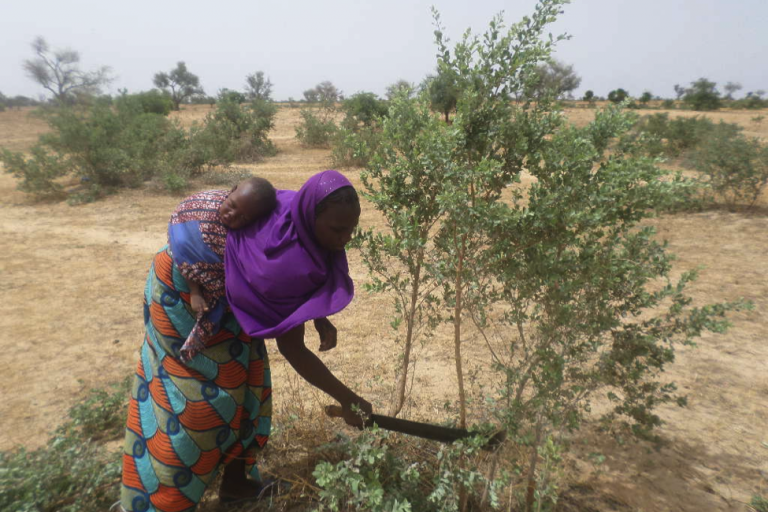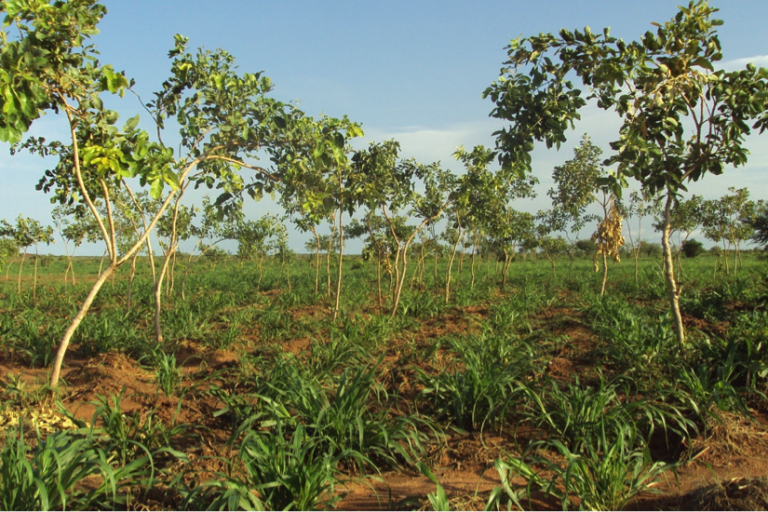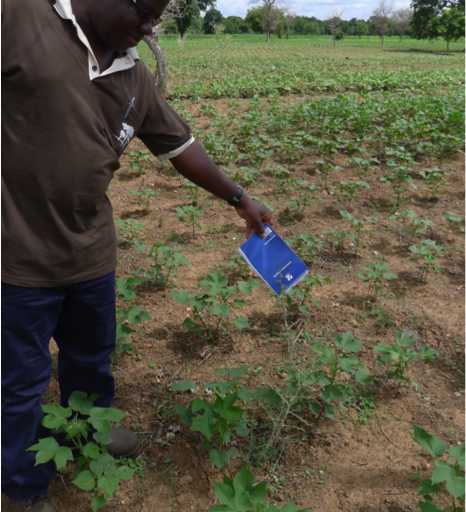Author: Cathy Watson | Published: June 29, 2018
Farmer-managed natural regeneration (FMNR) of trees made headlines several years ago when 5 million hectares of Niger were found to have re-greened via the practice. FMNR is the encouragement of regeneration (and then management) of trees and shrubs that sprout from stumps, roots, and seeds found in degraded soils, such as those currently under agricultural production. Once established in farm fields, these new woody plants improve soil fertility and moisture for crops planted in combination with them, in a system known as agroforestry.
The news from Niger provided hope that a low-tech and low-cost approach could succeed after many years of failed tree planting efforts. Researchers crowded in and found that FMNR increased grain yields by 30%, boosted incomes, and was climate smart.
But a decade later, two scientists from Burkina Faso associated with the World Agroforestry Centre (ICRAF) are still drilling down into the data.
Dr. Jules Bayala is Chief Scientist for the Sahel and Dr Patrice Sawadogo is a senior scientist. Cathy Watson, Chief of Programme Development at ICRAF, interviewed them for Mongabay about trees, soil carbon, and productivity to discuss whether FMNR is the fastest way to restore degraded landscapes, and if it has utility beyond drylands.
Cathy Watson: Why are you studying FMNR?
Patrice Savadogo: Since childhood I’d seen farmers regenerate trees. Then, when I grew up, experts claimed that FMNR is climate smart. Yet in the literature, we didn’t have sound evidence. I wanted to build scientific knowledge.

A farmer removes side stems from a Guiera senegalensis, the first step in encouraging the strong central stem to take advantage of the root system. Photo courtesy of ICRAF/P. Savadogo
Jules Bayala: FMNR had been practiced in Niger for quite some years. Yet nobody had assessed it systematically. We knew it was good, but by how much? Our idea was to be neutral.
Cathy Watson: You wanted more than positive stories. What else?
Patrice Savadogo: Well, we already knew that the most important thing that trees can do in the Sahel to sustain soil productivity is to improve soil carbon because that improves soil structure. The soil stays moist longer and that increases the ability of cereals to take up nutrients. So, we wanted to look at FMNR and carbon sequestration in trees and carbon accumulation in the soil.
Cathy Watson: And how have you been doing this?
Jules Bayala: Earlier studies used classes of adopters – people who adopted FMNR 15, 10, five years ago and those who had not adopted. So, we divided 160 farmers into those classes and sampled soil from the trunks of trees to the open area where we expected no tree effect.
Patrice Savadogo: We calculated above ground carbon by inventorying the species and numbers of trees and measuring the diameter of the stem and crown. To see what is going on below ground, we sampled soil to one meter deep.

At the World Agroforestry Centre, Dr Jules Bayala is Principal Scientist in the Sahel. Dr Patrice Savadogo is its Dryland Agroforestry System Scientist. Both from Burkina Faso and grew up watching their fathers work with trees. Image courtesy of ICRAF
Cathy Watson: What did you find?
Jules Bayala: If we look at the pattern of carbon, we see a decreasing amount going from tree trunk to the open area. It shows clearly that trees contribute to soil carbon. We can say definitively that FMNR replenishes carbon in soil.
Patrice Savadogo: Also important was that the more the soil is sandy, the bigger the effect of carbon addition. That is very critical because most soil in the Sahel is sandy. Generally, for carbon, FMNR is very good. We’ve measured other elements but, for the soil in the Sahel, carbon is key. You can bring in nitrogen. It is much more difficult to bring in carbon.
Cathy Watson: What do you mean by above and below ground carbon, and how do they relate to trees?
Jules Bayala: Carbon comes through photosynthesis. Photosynthesis takes carbon from the atmosphere and accumulates it as biomass. This biomass is recycled in the soil through leaf litter and root decay. In the soil’s top layer, carbon comes from leaves and animal droppings. Deeper down, it comes from fine root hairs that break down. By far the greatest amount of carbon in the soil comes from these roots for the simple reason that leaves get blown away and you have bush fires. What enters the soil from leaves is very little compared to what stays in the soil layer. Roots behave like leaves. The period you have the maximum leaves, you have a corresponding maximum of fine root hairs. When leaves decay, roots decay too.
Cathy Watson: And the relationship between FMNR, carbon and crop production?
Patrice Savadogo: Very strong. In fact, we believe that without FMNR, soil will have a very low yield or not produce any crop. Because the main problem with soil in the Sahel is the low carbon. We found that on farms where you have FMNR, soil carbon is better, and it relates to the presence of trees. Where you find a very limited number of trees, you find low production of cereals – maybe 200 kg/ha. As tree density increases, yield reaches 300 kg/ha. The most we found was 500 kg, usually where FMNR had been for quite some time. That doubling of yield is due to trees.

A field of millet in Mopti, Mali, already showing benefits from newly preserved individuals of Combretum glutinosum that a farmer is assisting to resprout from stumps. This is a fast-growing drought-resistant shrub common in the Sahel where rainfall is 200-700 mm per year. Photo courtesy of ICRAF/P. Savadogo
Cathy Watson: What about other benefits from FMNR?
Patrice Savadogo: Farms with no trees or a very limited number are more fragile when there is a shock. When you have a drought spell, the crops suffer more than in places with more trees. Crops that grow next to trees perform better than those further away because of the soil carbon but also the microclimate around the tree. You see the millet plant being taller with a bigger head of grain.
Cathy Watson: How does FMNR work? Is there a particular sequence?
Jules Bayala: FMNR is when farmers encourage naturally-occurring trees. In the 1970s in the Sahel, trees were top killed by a period of aridity and then cut for firewood. But the roots kept living in an underground forest. Farmers prune the stems from the living stumps to encourage the strongest ones to shoot up into trees. There is also germination of seeds from the bank of seed in the soil. But about 95% of the trees come from stumps.
Patrice Savadogo: The younger the farm is in its practice of FMNR, the less the tree diversity. Regeneration of those stumps and the germination of existing seed gives you trees. Those trees attract birds or mammals that bring in more seed, and you start to see new species and more diversity. In Niger, you start with Guiera senegalensis. The farmer will say, “This species was there when I started.” Then species like Acacia seberiana and Bosia sengalensis appear, and Balanitis aegyptiaca is brought in by camels in their droppings.
Cathy Watson: How many trees can a farmer achieve?
Jules Bayala: In the beginning they have few. They select and nurture them. Livestock are roaming around. You have to protect them until they reach a certain stage. It’s long. But the density can reach more than 200 stems per acre. Then farmers reach a point where they must reduce them. They get a lot of firewood that generates substantial income in countries like Niger where the fallows, bush and forest are gone.

Bayala showing a newly regenerated Faidherbia albida in a cotton field in Southern Burkina Faso. Besides fixing nitrogen, this species sheds its leaves during the cropping season thus competing less with annual crops for light. During the dry season, it puts out leaves, providing protein rich forage to livestock during this critical period of quality feed shortage. Image courtesy of ICRAF
Cathy Watson: Is it best to have many species or fine to have just Guiera, for instance?
Patrice Savadogo: Different species is best. We looked at the nitrogen-fixing trees and non-nitrogen fixers that farmers preserve. A farm with five to eight species, of which one to two are nitrogen fixers, will have more benefits for its soil than if you only have Guiera and Piliostigma, which don’t fix nitrogen.
Cathy Watson: Is FMNR better than planting trees?
Jules Bayala: It’s much easier. “Better” depends on what you want. If you are targeting soil restoration and wood energy, FMNR is far better. If you are targeting fruit trees and the seed for fruit trees is not in the soil, you will not get them. In the first years of FMNR, the farmer can only work from the stocks and seeds he has.
Cathy Watson: Are there limits to FMNR?
Patrice Savadogo: Yes, we cannot regreen only with FMNR. We must combine it with tree planting because if the farmer does not have rootstock, what do you regenerate? We also need to improve soil moisture because even with FMNR, if you don’t have good soil moisture, trees will not develop well. Zai pits, stone lines, and half-moon techniques hold water.
Jules Bayala: I agree. In this very harsh climate where you have eight months of no rain, you need those water conservation structures. They catch a seed as rain washes it along, and the space around them is a niche with higher humidity which helps the seed survive.
Cathy Watson: Is the case closed? FMNR is good?
Patrice Savadogo: No, we need to know more to recommend the optimum density and diversity of trees to optimize crop production.
Jules Bayala: It is not closed. We need permanent plots where you go back frequently and do the same measurements and get solid data showing the trend with time.
Cathy Watson: What about the farmers?
Patrice Savadogo: In Niger, farmers now preserve trees and are very discerning. They can say, “We don’t want Acacia. The thorns puncture our bike tires.” But they preserve Balanitis despite its thorns because it is big, the leaves are sauce and fodder, and the seeds give oil. Farmers know a lot. They regenerate trees by feeding seed to livestock – some germinates better if it goes through the gut. But we need still more uptake of FMNR in Niger and across the Sahel.
This feature is part of an ongoing series about the global implementation of agroforestry, view all articles in the series here.
Reposted with permission from Mongabay.




